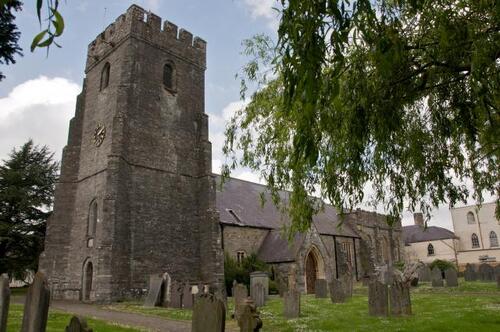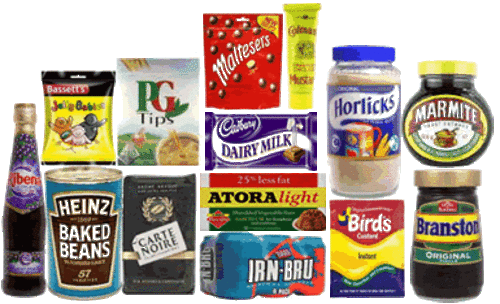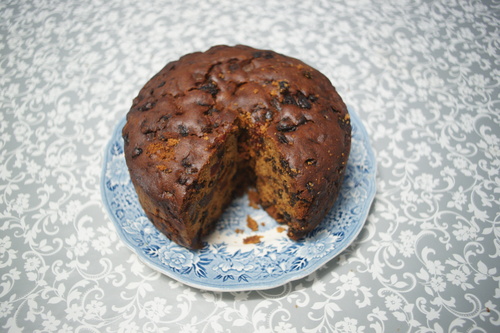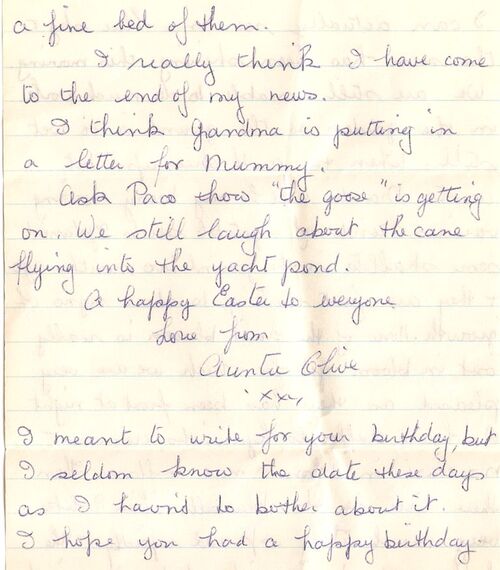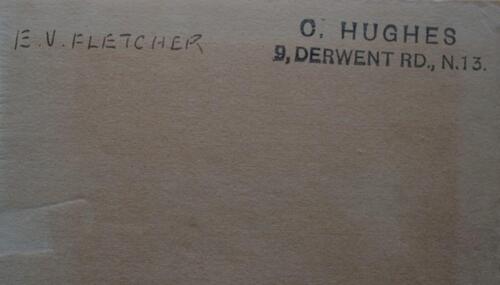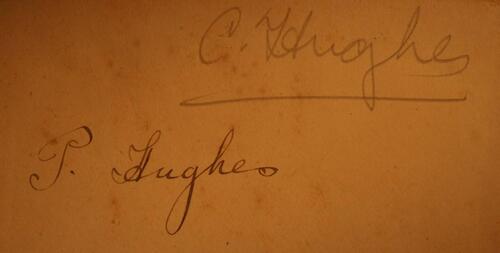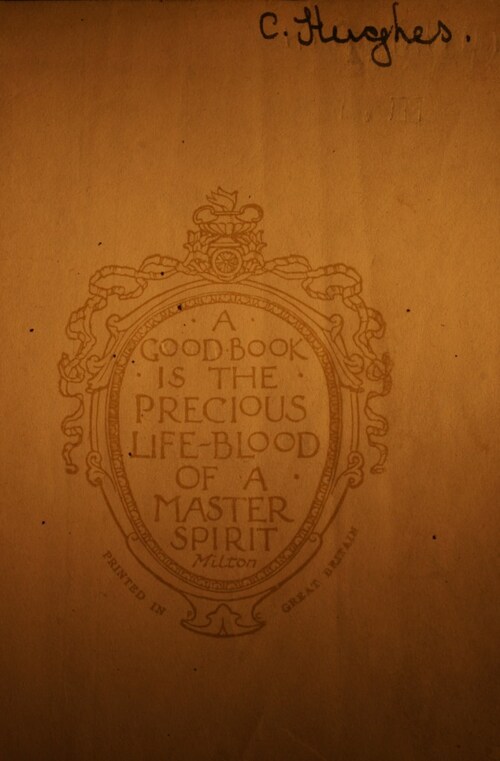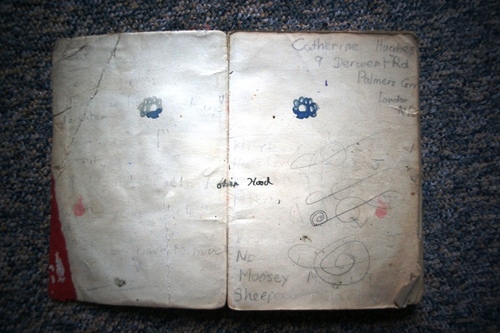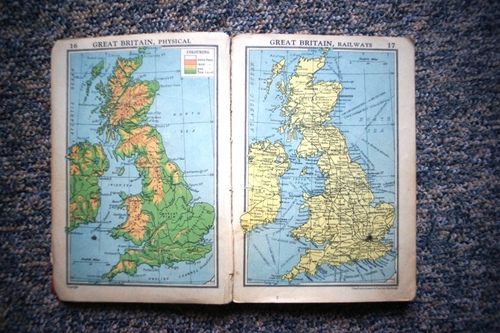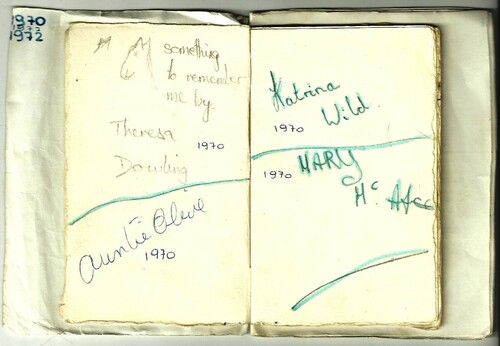-
Par yvesM le 19 February 2014 à 19:23
In the previous post on the subject, you remember perhaps Grandpa mentioning "popery"as a possible reason for intolerance towards Catholics in a predominently Anglican society... well, perhaps indeed what strikes one when remembering our grandparents' religious practice is the place taken by the Church (capital C), and even by churches. Have a look at this letter received from Auntie Olive:
The "churchy" bit is the one starting at the bottom of the first side and running till she announces she's going to proceed to correct some of my mistakes, a thing I had asked her to do. So she was responsible, together with Auntie Maude, for the upkeep of this place of pilgrimage in Cardigan, Wales. I went on the web to find the reference and apparently it's quite an important shrine, check here. And here is a nicely done timeline with no less than four references to the names Hughes. I wonder if this could be an indication as to why our great-aunts were involved there? One site writes about the pilgrimage: "The church was a twelfth century Benedictine foundation, and the present nave dates from the fourteenth century. St Mary's Priory church found fame as a site of pilgrimage in the thirteenth century, as the shrine of Our Lady of the Taper. This tradition was broken at the Reformation, but the shrine was re-established in the town by the Roman Catholic Church." You can have a look at pictures of a service here, and below is a picture of the old building (there is new pilgrimage centre now):
and inside:
So now we can picture the two Aunties in their Cardigan priory! But as to the reason why they regularly had to go there, I don't know. Perhaps one of the Hughes girls remembers? It is probable that, the place being a recently revamped place of pilgrimage, it needed attendance all year long, and that when the vicar would leave for some deserved holidays, the parish would call upon some good Catholic souls to tend the flock of pilgrims! Still, why would the Aunties have chosen Cardigan? I have half an idea that it could be connected with the shrine of Mary: very catholic people often have a weak spot for Mary
 And also the renewal of Catholic interest to this ancient place of worship was closely followed b the Catholic Evidence guild's Newsletter The Tablet!
And also the renewal of Catholic interest to this ancient place of worship was closely followed b the Catholic Evidence guild's Newsletter The Tablet!Further evidence of Catholic affairs can be seen on this blog: Bless this house; A mision back in 1981; Our christmased past.
I'll finish this double instalment by a scanned letter from Grandma, dated 1981, in which she expatiates about many subjects, but where you will certainly recognize her very religious way of looking at things. Naturally she knew I was myself open to this type of approach, but certainly she seizes the opportunity to voice remarks and beliefs which were of great importance to her:
 your comment
your comment
-
Par yvesM le 14 February 2014 à 00:32
...was an important aspect of life at 9DR. It didn't interfere a great deal with the happy holiday time which we spent when we came over though. We went to mass on Sunday, and at some early stage we did have a go at the Sunday school which was held at the back of Saint Monica's Church. But only later did I really recognize how religious all the dwellers of n°9 and n°7 had been, or at least, understood what it must have meant to live in such a religious environment. For example, mass was daily: perhaps this was a later development, because I don't know whether they would have managed when working. Of course, Monsieur Père was the prominently catholic figure. His stern ways, along with the occasional preachy aspects (see here) I remember well. Here's a recording of what he had to say (perhaps at the Catholic Evidence Guild) on the "job of the Church": And what would you say that was? To announce Jesus-Christ? To enable the faithful to lead a worthy community life? Wrong! Listen to Grandpa!
Here's a very interesting speech which he delivered to an audience of would-be speakers in public (perhaps at Speaker's Corner, where I know he was wont to go), with advice as to what to do and not to do, and which subjects were appropriate to listeners:
I have other, more directly theological speeches which Noël recorded - and which he therefore must also have listened to, bless him - but I'm not sure you'll be so interested. A good part of it contains such things as a discussion of the relative positions of the Son and the Father as seen in the gospel of saint John. If some are interested, I can upload them. On the whole, I think one can say that Monsieur Père was a staunch believer, a statement which for me is very positive; but I think one should also stress that he was dogmatic and rather naive in his rigid adherence to the teachings of the Church, even if this was the right way then. I cannot but admire his faith, which led him to publicly show it, and not be afraid to say it was the truth.
On the Saint Monica's parish website, I have been surprised to find a text which it is said had been written (in 1960) by "Cecil Hughes who, with his family, had been resident in the area for some time."
Here's what you can read:
At this point it is appropriate to include some of the memories of Cecil Hughes who, with his family, had been resident in the area for some time. He wrote as follows in 1960 in celebration of the golden jubilee of the parish under the title:
We were children then
"The tenth of July 1910 was a Sunday and Father Heditch said Mass that day at the house in Grovelands Road that was to do duty for some months as the parish church of Palmers Green.
We were not there long but amongst my recollections are of two men and the bell. One of the men was Sydney Joseph Carreras, a veteran doorkeeper who welcomed us warmly in the manner one associates more, alas, with the Free Churches than with our own and who did his job faithfully to the last. He died on duty, in the porch of St. Monica's at the half-past nine Mass on Palm Sunday 1927.
The other man was Joseph James Gamage who took up the collection (such as it was) with an almost ducal dignity. His death, too, was memorable to those of us who served the altar in those days for it was one of those rare occasions when priest and servers went to the house (50 The Mall) with holy water and then, all vested in cassocks and cottas and with the processional cross escorted the body to the church.
The bell, of course, was the one used at Mass but although no doubt very similar to the one at Wood Green, it sounded so different in the small space - just two sitting rooms knocked into one. The congregation hardly numbered fifty but we certainly hadn't that many chairs so the children sat on the floor right in front, a yard from the priest. And the bell was very close!
I'm afraid we didn't get on very well with the neighbours. It can't have been the bell but perhaps the hymns we sang were the wrong sort to make us popular in Grovelands Road - or perhaps it was our plain popery. Anyhow, we soon had to move. Thus it was that early in 1911 we found ourselves in a larger house standing in its own grounds in Green Lanes opposite St. John's Church, named Hazelwood House, a stone's throw from our present church. We were the last tenants - shops are there now.
Fr. Heditch, however, was a sick man and in the spring of 1912 he went on pilgrimage to Lourdes, a pilgrimage which was far from being the streamlined travel agency arranged sort of affair that is normal in 1960. He never came back to us and on June 29th our new rector came - that giant of purposeful drive and energy, Fr. Gallagher.
Those who knew him only in his declining years can form no idea of his former energy and those of us who knew him then can never forget it. For eleven years until his serious illness of 1923 he never rested, never tired. He did everything.
Within a year he had bought land which the owners (Barratt's the Sweet makers of Wood Green) didn't want to sell, put up a temporary church that lasted till 1930 when it had to be taken down to make room for our new hall, started a school and completed all the preliminaries for our new church which was opened by Cardinal Bourne on the feast of St. Monica in 1914. The chalice used on that occasion was given by the Cardinal to Fr. Gallagher with a letter written in his own hand which was always kept in the chalice case. One day – in 1925 I think it was - a casual thief walked in before Mass and went into the sacristy just as Fr. Gallagher had left it after putting the chalice, still in its case, on the vestment press. I was a little late, he came out as I went in. Of course we never saw the chalice again; but its replacement was the gift, anonymously at the time, of the late Theodore Singer whose other gifts, also made anonymously, included the mosaic work in the Sacred Heart chapel and its stained glass window."
I think it's rather fascinating to plunge all the way back to when Cecil was a boy attending mass in Saint Monica's back in the 1910s! Plus, it's a very interesting perspective on a Catholic parish and its classic trappings in pre-Vatican II times.
The church today
******
Here, you've already heard Grandma speaking about the Virgin Mary. Even if you're like me and you don't find what she says completely boring, I can well understand you might have preferred her when she was acting rather than preaching. Her faith was indeed active, and made her who she was, a warm and open-minded person with no dogmatic attitude that I can remember. Others don't share my point of view, I know, and certainly I was looked upon as not needing to be preached at, so this left me in greater peace than others... Still, I'm sure that Grandma's attitude, perhaps idealistic, perhaps even childlike when it came to her Catholic faith (I'm thinking of her passion for John Paul II), can even today be a model for those who wonder how faith can translate in our lives.
Both Monsieur Père and Grandma had been on pilgrimages to Jerusalem, to Rome, to Lourdes, and as I said, all of them went to mass every day - amazing feat when you come to think of it, every day! Of course Monsieur Père was the Church organist, and the three Aunties would be the community Frontbenchers - I can still see them kneeling on the front pews with their lace head scarves - devout, that is the word. But if devotion inspires you to be of material help to an increasingly large family, if it suggests you ways of assisting the young to climb the slope towards maturity, if it keeps a room open at home for those in need, and if it inspires to place life and its greatness before the individual needs and little worldly pursuits...
To be continued...
30/10/2014: during my visit to Mary and David in Woolpit, David mentioned Fr Gallagher's last period as vicar of St Monica's, saying that he "had gone gaga" and when preaching would turn not towards his parishioners but towards the Cross on the other side, much to everyone's dismay...
Noel also sent me this link, which contains some information about St Monica's church, on the occasion of its 100th anniversary:
http://issuu.com/tonyourris/docs/pg_life_jun14_final
There's also this nice and plentiful thread on the FB page devoted to Palmers Green: https://www.facebook.com/photo.php?fbid=1590612484328151&set=gm.1396195950506709&type=3&theater&ifg=1
The users try to remember all the priests who once served at Saint Monica's.
 4 comments
4 comments
-
Par yvesM le 2 February 2014 à 19:30
Seen from the French perspective, this subject is a double-sided one, because throughout my youth (and still now, come to think of it) people would always taunt me with the ordeal that (according to them) I must had gone through when in England. Not only did English food have a dreadful reputation (as you’ll read here in my description of school dinners!), but however hard I tried to explain that I loved Grandma’s meals, there would always be a comment on her watery cabbage and absence of taste, meaning that she didn’t know how to make good food because she herself didn’t care. My dad used to picture her trying to fill him with boiled meat and strange looking saltless veg. “More cabbage, Charles?” he would taunt, and he meant: what IS this stuff?
(some jars which used to be at 9DR in Grandma's kitchen)
(Other pots that were in Grandma's kitchen, or were they in Auntie Olive's?)
But annoyed as I was, I was unmoved. My truth was that I loved Grandma’s food, and that even if I knew of other places where the reputation of British grub corresponded to what French people said (and then I was pleased to concur, inwardly focussing on those places, and mentally separating 9DR from any confusion, but abandoning the task of explaining this difference), I knew that when I returned to the old home, I would relish whatever happened in her kitchen and was soon after transferred on the table. I’m not only referring to puddings, loganberry jelly as an absolute n°1, which was served with Walls vanilla ice-cream and maybe custard, but Grandma knew what I liked and I remember fondly her tomato salads, with fresh lettuce from the garden outside, her firm and tasty little potatoes, I used to love her Heinz soup (and we all did, including my critical dad, who imported it dutifully in the later years, and when we had it at home it was a treat), which was drunk with a round table spoon somewhat too wide for my mouth. She prepared fantastic bacon and eggs for us, with those amazing sausages and cooked tomatoes, of which there was never enough. Then she would always do some toast, and I can still see the size of the butter, its exact shade of yellow and the knife used to spread it.
Loganberries have only been known in France recently. But thanks to Auntie Olive and Auntie Maud (I think Olive was the original and genuine gardener; Maud put too much passion into it), they are an essential element of the magic of 9DR (together with gooseberries, which fewer people loved). Grandma’s stewed loganberries with custard was a rapturous experience. We would eat them either hot, just cooked, and that was fabulous (I would drain the juice from sheer greed), or we might have them cold, and then she would scoop them out of a jar which were stored like precious metal by Monsieur Père – was it in the cellar? – and it was just as fabulous. We might eat them with ice-cream then. There was loganberry jam of course (drives me silly just to think of it; I would actually eat spoonfuls) and loganberry jelly, thick syrupy jelly which was had with cake or biscuits – now I know why I’m an anglophile. In the summer, we would also go outside, and in spite of contrary orders, we would pick the fat juicy purple loganberries on their stalks: intoxicating! Soon we had some at home, because Mum had brought back stalks which quickly adapted to French soil, but nothing anyway could beat Grandma’s loganberry jars.
Now here is MP's Loganberry jam recipe, a copy found in Cath's cook book. What's interesting about it is the comment MP made about men using electric razors. What would that have to do with Loganberries, you'd surely wonder... ?
One special word about Marmite. I think that even in England, there are some people that didn’t / don’t like it. But I must have had some stirred in my feeding bottles because as soon as I think of the stuff, I start salivating! Mind you, it’s exactly what it does in reality: you still have it in your mouth hours after you’ve spread those thin scraps on buttered bread (another sign of partiality is my fondness for English bread, when I have French baguette to gorge on every day here!). We used to laugh so much to observe unsuspecting French people spread Marmite on bread, “to try”! At tea-time, I was the Marmite guy and Paco the Chocolate Spread one. Today, I still use it even if probably back in England it was part of a kind of vitamin-added diet which well-meaning grown-ups who had known the war thought was necessary. We were given Marmite as part of the system which made Grandma use TCP (another one of dad’s subjects of 9DR bashing), but we loved it.
When we went to school or out to London for the day, and she had to prepare a picnic for us, we had little custom-made bags:
(this is one the original ones which Noel has kept, God knows how)
And inside were the revered sandwiches (pronounced sambwiches) cut in manageable squares and wrapped in some unremembered paper, but what I do remember was that we would have lamb in the middle, with chutney and lettuce, tomato slices: goodness they tasted like Heaven. Then there was some orange juice which Grandma had squashed for us, and maybe two Penguin biscuits in their brightly coloured foil, which was the promise of their amazing minute of pure crunchy delight, or a Kitkat bar which I also relished. Finally an apple which I ate even if they didn’t taste (this time) as good as the ones we had in France. And in the shops, we marvelled at the incredible head start which the British had over us in terms of candies! These names: Flake, Malteasers, Crunchie, Rolo, Fruit gums, Smarties, Chocolate drops, Curly Wurly, evoke such a richness of memories that I could speak about them for hours, it seems!
Ah, and of course, jelly babies: were you among Grandpa’s grandchildren whom he unknowingly doomed to adult-life visits to the dentist? Well I certainly was. He would come in our bedroom after we had switched off the light (we knew he was coming!), and after we had brushed our teeth, and asked us the now-mythical question: “what colour, the jelly baby?” (I suppose his bag was sufficiently lit by the opened door): we told him, and he popped it in our mouths! I bet he didn't tell mum in those days!
For fun: here’s some quizzes about “Classic British sweets”!
To finish with sweets, I’m sure you were all wondering: “Is he going to mention Monsieur Père cake”?? Certainly everyone knows what we used to call like that, but perhaps under a different name? It’s the rich fruit cake that he baked, and which Grandma took over making when he died. I don't know whether it wasn't his version of Christmas pudding? But had it at other periods of the year too, I believe. She used to put rather too much of the thick icing though, and I think the last times when we had it (Mum brought it back with her when she went to London every November, and so it was ready for Christmas), I was a little choked by it. But the inside was gorgeous, a thick mix of fruit, nuts and – from what I heard, fat, which had cooked for hours… We ate it religiously, and this time even my dad considered which expression of appreciation he would use.
The big pan was used to make the Monsieur Père cake. Cath inherited from these and would use it for the same purpose. She used the two flat ones to make some hard rock toffees.
Today I have the reputation of a die-hard supporter of English food, when really I am just thankful for Grandma’s adaptative skills to our tastes – I know she would serve us what we liked – and the genuine quality of some of the simple but very good dishes we had at her table. A good deal came from her garden, so it had to be good anyway. Okay, I’m partial, I know, because Grandma’s food was mixed with the pleasure of holidays, and perhaps if I’d lived there on a regular basis, such things as breakfast Rice Krispies would have started tasting the same as their continental equivalent (but they weren’t, I swear, they had a crispiness and a flavour of their own!) I’m known for my love of (and supposedly masterful skill at making) custard, of jelly, of PG tips tea and Marmite (among other things). All of which are looked down upon by Frédérique who even if she’s long been a sedate observer of these whims of mine, cannot really comprehend what they mean. There’s one food obsession of mine which doesn’t come from 9DR, and that’s Weetabix. At Grandma’s I would always have Rice Krispies (sometimes Corn Flakes) and Monsieur Père would make me listen to the crackling noises inside the pile of crispies as soon as he had poured the milk. The liking for Weetabix started during my Youth hostels tours of Great Britain, in my twenties.
There are some 9DR foods which I never really managed to adopt, one such being porridge, which I saw the two grandparents eat at breakfast (and which I think Grandma had as a replacement dinner some days). I would marvel at the solidification process of the oats in Monsieur Père’s plate, with the brown sugar he would sprinkle over them, and his way of eating from the sides, because they were colder. I think it’s because I never really enjoyed warm milk. And that’s also, perhaps, why I rather quickly switched from white to black tea. Today I almost never have milk in my tea, unless I’m with some people who served it to me without asking, or if it’s Indian chai ! But one thing is sure: it’s got to be PG tips! There are many types of tea which I certainly would like, but none that I have adopted to replace it. I store those big 240 teabag boxes when we come back from England (once there were 8 in our Morrison’s trolley), and recently I took advantage of going to Paris to sneak into an Indian food shop near Gare du Nord, to get my ration (you can’t buy PG tips in ordinary supermarkets in France)!
Grandma would make us tea all the time, very much in the English fashion: “would you like a cuppitee?” she would chime, and that tea of hers wasn’t what the French like in it – an experience into a rarity of exotic tastes – no, it was feeling good together and anticipating a need which was assumed to be always there. And for that you don’t need (nay you mustn’t) be diverted by: “what sort of tea will you have?” You’re given tea (and maybe biscuits) as a matter of course. It’s part of the home.
To finish off, a few pictures of utensils which I might not have posted before:
some tea-caddies, or flour?
Grandpa's scales, I remember him weighing his potatoes on this (there would have been a little aluminium saucer on top)
here's another one, perhaps for letters, I think, not food.
A tea tin, I think.
Some cutlery which belonged to Auntie Olive, perhaps (photo sent by Hélène)
How many cuppas were drunk in this one??
 4 comments
4 comments
-
Par yvesM le 26 January 2014 à 21:10
"Johnny Crow would dig and sow, till he made a little garden"
Dear everyone,
Were you read this funny book? I think it was one of Auntie Olive's favourite. Noel scanned some pages of it for me - I suppose the original is in Bonnebosq - and I laughed again at watching the adventures of the lion, the bear, the goose (which was a goose!) and many other zany creatures which lived and busied themselves in Johnny Crow's garden!
Trouble is, he only sent me a few of the pages, so I decided to look for the complete story, so here's the whole book (click on the HTML link), first written by L. Leslie Brooke in 1903. It was made fully available on The Project Gutemberg website.
The fun of the story is the Alice Caroll-like treatment of preposterous animal habits which are all absolutely out of context, and made to submit to the whims of an ingenious rhyme-master: so for example, the only thing that could happen to the Beaver was to have a fever, and the only dance which the pig could dance was... (if you can't guess, check the book!)
And now for some "goose" documents, because there was a line in the book which gained the status of catchword, probably because there must have been some game linked with it, or a particular childish enjoyment of the fun contained in the animal...
Below is a letter where Auntie Olive reminds me of the famous line!
I also have a birthday card sent (perhaps later, it doesn't have a date) to me by Grandma. This is the front:
And the quack back:
In this letter to Paco, Auntie Olive refers to the goose again, even if I'm not sure whether it's the one in the story (but you'll enjoy her sense of humour!):
There must have been a special reference between Paco, Auntie Olive and the goose!! Check this:
 your comment
your comment
-
Par yvesM le 6 January 2014 à 00:06
Over the recent months, I had kept some copies of signatures from the family, and then recently Noel has sent me many more, photographed from Mum's books at home, so it clenched it: a post on this subject! We start with Ethel (I presume E.V. Fletcher refers to her...). I'm not sure that her name was actually written by her, though:
this one is a more likely candidate (but I'm not sure why Grandpa would have needed to stamp his name & address on the books):
then a signature which might be attributable to Percy Hughes, Grandpa's father (with the latter's signature above it?):
Here is a mystery dedication - if anyone has any idea? Could it be Percy again? (I suppose I should simply ask mum! after all, it has her [married] signature at the top):
This must be the prize sticker of a book which Grandma was bestowed as a girl back in 1925 in Rothbury (again appropriated by Grandpa!):
An inscription by Auntie Blandine, probably on Cath's birthday:
There are two dedicatory notes from "Auntie Jean and Uncle George", which AB speaks about in relation to the picture of the family on a boat in Cornwall (here): one for Cath's 13th birthday, and one for her 14th:
Then there are naturally a number of little indications bearing Cath's name and signature:
Upper IV was when she was 14. Below is a reference to a prize she must have been awarded for writing an article in the school magazine (?)
This is the inside of the following, but note the inscription "Robin Hood"! - no connection with geography, is there?
Some of her signatures seem to indicate a sort of progression, as when one tries which signature corresponds best:
Look below: she had gone to a St Ignatius Garden party in 1953?! Must have been well chaperoned...
Forlorn River is a novel by Zane Grey.
Then there's this rather interesting dedication by her "Pseudo-godfather" (Noël indicates he's the Sheed of the top lettering, a catholic publisher - check here too), introducing another dedication by author DB Wyndham Lewis, whom Daddy Cecil would certainly have approved of, since he was a Catholic convert:
Wyndham Lewis's book on Ronsard is dated 1946: Cath might well have waited another 7 or 8 years to begin to be interested in French poetry, but I would have to ask her about the circumstance of this gift.
Here's an autograph by Grandpa about a Christmas competition which took place in 1949, but with Veronica's name this time:
 Then we have some later signatures which Hélène had scanned for me from the signature book that she had filled with friends and families' signatures in 1970:
Then we have some later signatures which Hélène had scanned for me from the signature book that she had filled with friends and families' signatures in 1970:This page contains Auntie Olive's name, alongside some compliant friends! (I wonder if Theresa's horse enabled her to be remembered...)
And to finish, Monsieur Père's pet "Bunny signature", which we all loved:
 your comment
your comment Follow this section's article RSS flux
Follow this section's article RSS flux Follow this section's comments RSS flux
Follow this section's comments RSS flux

